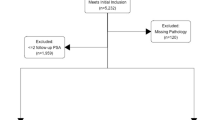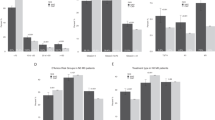Abstract
To evaluate whether race modifies the accuracy of nomograms to predict biochemical recurrence (BCR) after radical prostatectomy among subjects from the Shared Equal Access Regional Cancer Hospital (SEARCH) and Duke Prostate Center (DPC) databases. Retrospective analysis of 1721 and 4511 subjects from the SEARCH and DPC cohorts, respectively. The discrimination accuracy for BCR of seven previously published predictive models was assessed using concordance index and compared between African-American men (AAM) and Caucasian men (CM). AAM represented 44% of SEARCH and 14% of DPC. In both cohorts, AAM were more likely to experience BCR than CM (P<0.01). In SEARCH, the mean concordance index across all seven models was lower in AAM (0.678) than CM (0.715), though the mean difference between CM and AAM was modest (0.037; range 0.015–0.062). In DPC the overall mean concordance index for BCR across all seven nomograms was 0.686. In contrast to SEARCH, the mean concordance index in DPC was higher in AAM (0.717) than CM (0.681), though the mean differences between CM and AAM was modest (−0.036; range −0.078 to −0.004). Across all seven models for predicting BCR, the discriminatory accuracy was better among CM in SEARCH and better among AAM in DPC. The mean difference in discriminatory accuracy of all seven nomograms between AAM and CM was approximately 3–4%. This indicates that currently used predictive models have similar performances among CM and AAM. Therefore, nomograms represent a valid and accurate method to predict BCR regardless of race.
This is a preview of subscription content, access via your institution
Access options
Subscribe to this journal
Receive 4 print issues and online access
$259.00 per year
only $64.75 per issue
Buy this article
- Purchase on Springer Link
- Instant access to full article PDF
Prices may be subject to local taxes which are calculated during checkout


Similar content being viewed by others
References
Chun FK, Karakiewicz PI, Briganti A . Prostate cancer diagnosis: importance of individualized risk stratification models over PSA alone. Eur Urol 2008; 54: 241–242.
Shariat SF, Karakiewicz PI, Roehrborn CG, Kattan MW . An updated catalog of prostate cancer predictive tools. Cancer 2008; 113: 3075–3099.
Hamilton RJ, Aronson WJ, Presti Jr JC, Terris MK, Kane CJ, Amling CL et al. Race, biochemical disease recurrence, and prostate-specific antigen doubling time after radical prostatectomy: results from the SEARCH database. Cancer 2007; 110: 2202–2209.
Bianco Jr FJ, Kattan MW, Scardino PT, Powell IJ, Pontes JE, Wood Jr DP . Radical prostatectomy nomograms in black American men: accuracy and applicability. J Urol 2003; 170: 73–76; discussion 76–77.
Schroeck FR, Sun L, Freedland SJ, Jayachandran J, Robertson CN, Moul JW . Race and prostate weight as independent predictors for biochemical recurrence after radical prostatectomy. Prostate Cancer Prostatic Dis 2008; 11: 371–376.
Fitzsimons NJ, Sun LL, Dahm P, Moul JW, Madden J, Gan TJ et al. A single-institution comparison between radical perineal and radical retropubic prostatectomy on perioperative and pathological outcomes for obese men: an analysis of the Duke Prostate Center database. Urology 2007; 70: 1146–1151.
Freedland SJ, Amling CL, Dorey F, Kane CJ, Presti Jr JC . Terris MK et al. Race as an outcome predictor after radical prostatectomy: results from the Shared Equal Access Regional Cancer Hospital (SEARCH) database. Urology 2002; 60: 670–674.
Freedland SJ, Sutter ME, Dorey F, Aronson WJ . Defining the ideal cutpoint for determining PSA recurrence after radical prostatectomy. Prostate-specific antigen. Urology 2003; 61: 365–369.
Harrell Jr FE, Califf RM, Pryor DB, Lee KL, Rosati RA . Evaluating the yield of medical tests. JAMA 1982; 247: 2543–2546.
D’Amico AV, Whittington R, Malkowicz SB, Schultz D, Blank K, Broderick GA et al. Biochemical outcome after radical prostatectomy, external beam radiation therapy, or interstitial radiation therapy for clinically localized prostate cancer. JAMA 1998; 280: 969–974.
Stephenson AJ, Scardino PT, Eastham JA, Bianco Jr FJ, Dotan ZA, Fearn PA et al. Preoperative nomogram predicting the 10-year probability of prostate cancer recurrence after radical prostatectomy. J Natl Cancer Inst 2006; 98: 715–717.
Stephenson AJ, Scardino PT, Eastham JA, Bianco Jr FJ, Dotan ZA, DiBlasio CJ et al. Postoperative nomogram predicting the 10-year probability of prostate cancer recurrence after radical prostatectomy. J Clin Oncol 2005; 23: 7005–7012.
Cooperberg MR, Pasta DJ, Elkin EP, Litwin MS, Latini DM, Du Chane J et al. The University of California, San Francisco Cancer of the Prostate Risk Assessment score: a straightforward and reliable preoperative predictor of disease recurrence after radical prostatectomy. J Urol 2005; 173: 1938–1942.
Moul JW, Connelly RR, Lubeck DP, Bauer JJ, Sun L, Flanders SC et al. Predicting risk of prostate specific antigen recurrence after radical prostatectomy with the Center for Prostate Disease Research and Cancer of the Prostate Strategic Urologic Research Endeavor databases. J Urol 2001; 166: 1322–1327.
Roberts WW, Bergstralh EJ, Blute ML, Slezak JM, Carducci M, Han M et al. Contemporary identification of patients at high risk of early prostate cancer recurrence after radical retropubic prostatectomy. Urology 2001; 57: 1033–1037.
Tewari AK, Gold HT, Demers RY, Johnson CC, Yadav R, Wagner EH et al. Effect of socioeconomic factors on long-term mortality in men with clinically localized prostate cancer. Urology 2009; 73: 624–630.
Rogers LQ, Courneya KS, Paragi-Gururaja R, Markwell SJ, Imeokparia R . Lifestyle behaviors, obesity, and perceived health among men with and without a diagnosis of prostate cancer: a population-based, cross-sectional study. BMC Public Health 2008; 8: 23.
Platz EA, Rimm EB, Willett WC, Kantoff PW, Giovannucci E . Racial variation in prostate cancer incidence and in hormonal system markers among male health professionals. J Natl Cancer Inst 2000; 92: 2009–2017.
Gilligan T, Wang PS, Levin R, Kantoff PW, Avorn J . Racial differences in screening for prostate cancer in the elderly. Arch Intern Med 2004; 164: 1858–1864.
Grossfeld GD, Latini DM, Downs T, Lubeck DP, Mehta SS, Carroll PR . Is ethnicity an independent predictor of prostate cancer recurrence after radical prostatectomy? J Urol 2002; 168: 2510–2515.
Konety BR, Cowan JE, Carroll PR . Patterns of primary and secondary therapy for prostate cancer in elderly men: analysis of data from CaPSURE. J Urol 2008; 179: 1797–1803; discussion 1803.
Nielsen ME, Han M, Mangold L, Humphreys E, Walsh PC, Partin AW et al. Black race does not independently predict adverse outcome following radical retropubic prostatectomy at a tertiary referral center. J Urol 2006; 176: 515–519.
Heath EI, Kattan MW, Powell IJ, Sakr W, Brand TC, Rybicki BA et al. The effect of race/ethnicity on the accuracy of the 2001 Partin Tables for predicting pathologic stage of localized prostate cancer. Urology 2008; 71: 151–155.
Justice AC, Covinsky KE, Berlin JA . Assessing the generalizability of prognostic information. Ann Intern Med 1999; 130: 515–524.
Acknowledgements
Department of Veterans Affairs, National Institute of Health R01CA100938 (WJA), NIH Specialized Programs of Research Excellence Grant P50 CA92131-01A1 (WJA), the Georgia Cancer Coalition (MKT), the Department of Defense, Prostate Cancer Research Program, (SJF), and the American Urological Association Foundation/Astellas Rising Star in Urology Award (SJF). Views and opinions of, and endorsements by the author(s) do not reflect those of the US Army or the Department of Defense.
Author information
Authors and Affiliations
Corresponding author
Rights and permissions
About this article
Cite this article
Moreira, D., Presti, J., Aronson, W. et al. The effect of race on the discriminatory accuracy of models to predict biochemical recurrence after radical prostatectomy: results from the Shared Equal Access Regional Cancer Hospital and Duke Prostate Center databases. Prostate Cancer Prostatic Dis 13, 87–93 (2010). https://doi.org/10.1038/pcan.2009.48
Received:
Revised:
Accepted:
Published:
Issue Date:
DOI: https://doi.org/10.1038/pcan.2009.48
Keywords
This article is cited by
-
Model risk scores may underestimate rate of biochemical recurrence in African American men with localized prostate cancer: a cohort analysis of over 3000 men
Prostate Cancer and Prostatic Diseases (2023)
-
Genome-wide detection of allelic genetic variation to predict biochemical recurrence after radical prostatectomy among prostate cancer patients using an exome SNP chip
Journal of Cancer Research and Clinical Oncology (2015)



